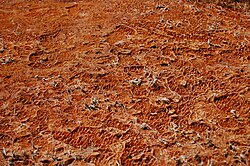Biofilm
A biofilm is any group of microorganisms which stick to cell surfaces.[1]
These sticky cells create a slimy layer outside the cells of the body. The cells in the biofilm produce extracellular polysaccharides, proteins, lipids and DNA.[2] Because they have three-dimensional structure they are a community lifestyle for microorganisms. They have been metaphorically described as "cities for microbes".[3][4]
The biofilm bacteria can share nutrients and are sheltered from harmful factors in their local environment, such as desiccation, antibiotics, and the host's immune system. The film of bacteria which live on your teeth are an example. Biofilms also form on inorganic objects like stones in water.
Biofilm Media
Staphylococcus aureus biofilm on an indwelling catheter
Probable cyanobacteria in the vertical section of a silicified biofilm from the Lower Cretaceous.*Very shallow hypersaline environment of the Urgonian carbonate platform of Provence, south eastern France.
Biofilm of golden hydrophobic bacteria; ceiling of Golden Dome Cave, a lava tube in Lava Beds National Monument
Five stages of biofilm development (1) Initial attachment, (2) Irreversible attachment, (3) Maturation I, (4) Maturation II, and (5) Dispersion. Each stage of development in the diagram is paired with a photomicrograph of a developing P. aeruginosa biofilm. All photomicrographs are shown to the same scale.Mats of bacterial biofilm color the hot springs in Yellowstone National Park. The longest raised mat area is about half a meter long.
Thermophilic bacteria in the outflow of Mickey Hot Springs, Oregon, approximately 20 mm thick.
References
- ↑ López, Daniel; Vlamakis, Hera; Kolter, Roberto (2010). "Biofilms". Cold Spring Harbor Perspectives in Biology. 2 (7): a000398. doi:10.1101/cshperspect.a000398. ISSN 1943-0264. PMC 2890205. PMID 20519345.
- ↑ Aggarwal, S; Stewart, P; Hozalski, R (2016). "Biofilm Cohesive Strength as a Basis for Biofilm Recalcitrance: Are Bacterial Biofilms Overdesigned?". Sage Journals. 8 (suppl 2) (Suppl 2): 29–32. doi:10.4137/MBI.S31444. PMC 4718087. PMID 26819559.
- ↑ Watnick, P.; Kolter, R. (2000). "Biofilm, city of microbes". Journal of Bacteriology. 182 (10): 2675–2679. doi:10.1128/jb.182.10.2675-2679.2000. ISSN 0021-9193. PMC 101960. PMID 10781532.
- ↑ "Building Codes for Bacterial Cities | Quanta Magazine". Quanta Magazine. https://www.quantamagazine.org/building-codes-for-bacterial-cities-20170725/. Retrieved 2017-07-25.







